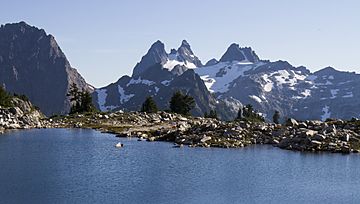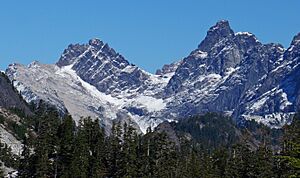Overcoat Peak facts for kids
Quick facts for kids Overcoat Peak |
|
|---|---|

The double summit Chimney Rock centered with Overcoat Peak to right. Lower Tank Lake in foreground.
|
|
| Highest point | |
| Elevation | 7,432 ft (2,265 m) |
| Prominence | 632 ft (193 m) |
| Geography | |
| Location | King County, Washington, U.S. |
| Parent range | Cascade Range |
| Topo map | USGS Big Snow Mountain |
| Climbing | |
| First ascent | July 1897 by Albert H. Sylvester and John Charlton |
Overcoat Peak is a tall mountain located in the Mount Baker-Snoqualmie National Forest in Washington, USA. It stands at 7,432 feet (2,265 m) (about 2,265 meters) high. This peak is less than half a mile northwest of Chimney Rock. Both are found within the beautiful Alpine Lakes Wilderness, a large protected area. You can also find the Overcoat Glacier on the east side of Overcoat Peak.
Overcoat Peak got its name from Albert Hale Sylvester. In 1897, he was on a trip to survey the area and accidentally left his coat on the mountain. This trip was also the first time anyone had climbed to the top of Overcoat Peak!
Mountain Weather
Overcoat Peak is in a special weather area called the marine west coast climate zone. This means it's near the ocean and gets a lot of moisture. Most of the weather systems, like big clouds and storms, start over the Pacific Ocean. They then travel northeast towards the Cascade Mountains.
When these weather systems hit the tall Cascade Mountains, they are forced to rise. As the air goes higher, it cools down and drops its moisture. This process is called orographic lift. Because of this, the western side of the Cascade Mountains gets a lot of rain or snowfall, especially in winter.
In winter, the weather is often cloudy. But in summer, big areas of high pressure over the Pacific Ocean usually bring clear skies. The snow here tends to be wet and heavy because of the ocean's influence. This can sometimes lead to a high risk of avalanches, which are large slides of snow down a mountain.
How the Mountain Was Formed
The Alpine Lakes Wilderness area, where Overcoat Peak is located, has some of the most rugged and dramatic landscapes in the Cascade Range. You can see jagged peaks, sharp ridges, deep valleys carved by glaciers, and tall granite walls. There are also more than 700 mountain lakes scattered around! All these different features and the big changes in elevation were created by amazing geological events that happened millions of years ago.
The story of how the Cascade Mountains formed goes back millions of years. It started during the late Eocene Epoch. At that time, the North American Plate (a huge piece of Earth's crust) was slowly moving over the Pacific Plate. This movement caused a lot of volcanic activity, creating new rocks.
Also, small pieces of Earth's crust, called terranes, came together to form the North Cascades about 50 million years ago.
Later, during the Pleistocene period (which started over two million years ago), huge sheets of ice called glaciers repeatedly moved across the land. As they moved, they scraped away and left behind lots of rock debris. The last time these glaciers retreated from the Alpine Lakes area was about 14,000 years ago. They had moved north of the Canada–US border by 10,000 years ago.
The "U"-shaped valleys you see in the mountains today are a direct result of these glaciers. The combination of the land being pushed up (called uplift) and cracks forming in the Earth's crust (called faulting), along with the powerful action of glaciers, created the tall peaks and deep valleys of the Alpine Lakes Wilderness.
Images for kids





